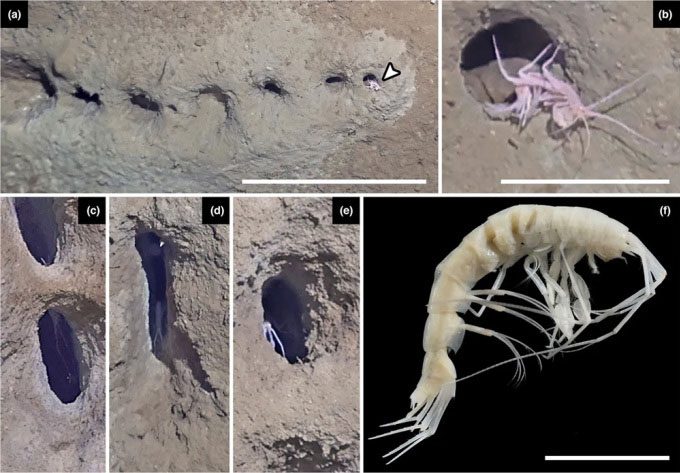Long rows of approximately half a meter containing numerous strange small holes at the bottom of the Bering Sea may be the handiwork of crustacean organisms.
From July to September 2022, a team of scientists embarked on the AleutBio Expedition in the North Pacific to study the biodiversity of the Aleutian Trench, a deep fissure 7 kilometers below the ocean floor near Alaska. However, the research vessel also sampled three sites in the nearby Bering Sea.

Crustacean organisms appearing inside some holes at the bottom of the sea. (Photo: Ecology and Evolution)
While reviewing footage captured by the expedition’s camera, the research team discovered strange rows of small holes, approximately 0.5 meters in length at the seabed, according to Julia Sigwart, an expert at the Senckenberg Research Institute and the Frankfurt Natural History Museum. “We continued to encounter them time and again. We saw them hundreds of times at three different locations,” she stated.
The prevalence of these rows of holes piqued the researchers’ curiosity. They examined the footage to learn more about them. Externally, they appeared similar to the mysterious rows of holes observed on the Mid-Atlantic Ridge for decades.
Upon reviewing the footage of the holes from various angles, the team of experts noted that they were interconnected by a horizontal tunnel beneath, as reported by IFL Science on April 10. In total, they documented nearly 200 such tunnels, each containing multiple holes. They discovered 96 species of animals active above or within the holes and questioned which, if any, of these species were the architects of this flute-shaped structure.
Later, when they spotted a pink amphipod (specifically from the Amphipoda order), seemingly belonging to the genus Maera, in one of the holes, the experts speculated that they might have found the answer. This organism was of appropriate size and possessed specialized legs for digging. However, Sigwart suggested that another species living in the deep sea may have created the holes on the Mid-Atlantic Ridge.
Sigwart opined that it is likely that the crustacean organisms dug the holes for shelter or nesting. “They also use this structure to access nutrient-rich layers located beneath the surface,” she explained.
Many other species also congregate around and within the holes. The digging activity may also help circulate chemicals within the ecosystem, according to Jennifer Durden, an expert at the National Oceanography Centre in Southampton, England. Durden noted that in the deep sea, there are not many physical processes to mix sediments. Therefore, it is primarily burrowing animals that help to stir up the mud.
Crustacean organisms play a vital role as engineers of the deep-sea ecosystem, significantly impacting the ecosystem there. However, scientists understand very little about them. According to Sigwart, it is likely that the organisms creating the rows of holes in the Bering Sea are a new species that needs to be named and scientifically described. The new study has been published in the journal Ecology and Evolution.


















































